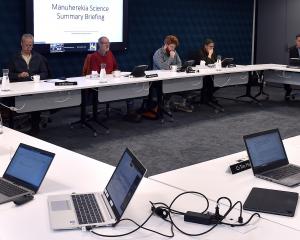
The DCC has decided to spend $60 million on a central city upgrade, and to consult everyone on the idea that those who trade from the central city should pay for 10% of the ‘‘upgrade’’ on the basis these businesses stand to gain the most financially from the improvements.
We are informed that there will be ‘‘key transformative projects’’ creating ‘‘compelling attractive spaces’’. While there are some suggestions as to what these may be, it is not at all clear where the planners will go after their ‘‘consultation’’. We can have no idea about whether there is likely to be any financial advantage to downtown ratepayers.

Cr David Benson-Pope said we had allowed the central city to look a bit tired and that ‘‘it’s absolutely essential that we commit to this work’’.
Deputy mayor Chris Staynes was prepared to go further and say that if the council did nothing ‘‘we will see the death of our city centre’’.
Stirring words indeed for spending of $60 million without any real idea of what they were voting for. (By ‘‘they’’ I mean all except Cr Vandervis and Cr Hall).
Imagine if you did that at home with your own money.
That is certainly not how such decisions should work.
We should start with an idea of what might need doing and then cost it and vote for it.
To help them out, I have recently done some research, polling and general feedback gathering.
I have established what is needed in our central city.
We could do with an app which visitors and locals alike could reference to give details of where toilets are and when they are open. The app could also provide maps showing walks around the city , particularly the central city, and include street art, historic buildings, facilities such as the art gallery, the museum, the Chinese Garden and library and their opening times.
We could give information about bus services in the app. Currently, on top of the $60 million the DCC is looking at a free bus loop around the central city (cost of research $400,000). For that price we could look at a hop on, hop off service which people happily pay for all over the world taking in the sights.
We could have asphalt on the footpaths, coloured in some parts if necessary.
We could provide a water feature in the Octagon as part of a revamp. Maybe a fountain?
Many visitors apparently like to wander round the centre of a city and have food and drinks, so making the Octagon better to look at would be welcome without a prohibition on cars so taxis etc can continue to access the businesses.
A major activity for locals and visitors alike is retail therapy. Wandering around a city popping in and out of shops is popular.
And while trees and other street furniture may enhance the attractiveness of the streets, nothing says sad like empty shops with to lease signs. The tree in this accompanying picture and the helpful rubbish bins do not make the disconsolate photo any better.
So how much would it cost and who should pay?
The plans I have consulted on (and therefore have a mandate for) will be nearer $5 million.
Avoiding pavers will save us a repetition of the earlier pavers which were not fit for the job and had to be replaced at our cost. And have the advantage of not tripping up pedestrians.
If the city feels obliged to spend more, we could have more car parks. When supermarkets and other retailers create their own destination shopping they start with plenty of parks. Surely, they know something about enticing people to enjoy an experience.
As regards who should pay, we could do well to think of what the central city ratepayers already pay.
We had businesses asking for compensation as a result of the bus hub development. While this was never likely, the idea of charging a business their ‘‘share’’ of $6 million extra to have their business disrupted for 18 months is surely crazy talk. For retail shops, charging them an extra amount on their rates will likely lead to even more empty shops and a detraction in the look and feel of downtown.
If the city is to be more user friendly, and if, as Chris Staynes says, Dunedin’s main street is to be protected from internet shopping, let’s make changes which involve minimal disruption and are a vision shared and paid for by everyone.
Hilary Calvert is a former lawyer, politician and city councillor.












